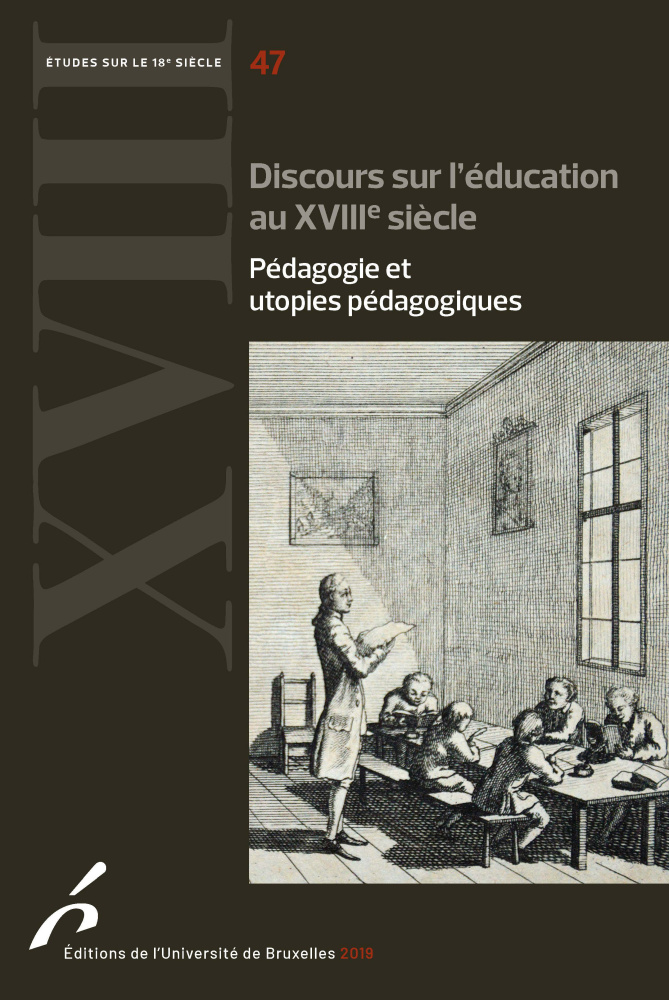Discours sur l'éducation au XVIIIe siècle
Pédagogie et utopies pédagogiques
First Edition
La publication par John Locke de son célèbre Essay Concerning Human Understanding (1690) puis de Some Thoughts Concerning Education (1694) a marqué un véritable tournant dans le discours européen sur l'éducation. Read More
Ces deux ouvrages consacrent la défaite définitive de l'innéisme cartésien et leibnizien au profit d'un empirisme pédagogique qui fait de l’esprit de l’enfant une tabula rasa que les pédagogues auront pour tâche d’alimenter. Plus tard, en proposant, dans Émile, ou de l’éducation (1762), une éducation plus proche de « la Nature », Jean-Jacques Rousseau a posé un autre jalon majeur au sein du discours éducatif et a fait de nombreux disciples, tant professionnels qu’amateurs. Malgré cela, on le verra, le discours utilitariste d’adaptation de l’individu à la société a néanmoins continué à avoir, tout au long du siècle, de nombreux adeptes, notamment au sein des milieux bourgeois.
C’est essentiellement au sein de ce cadre théorique contrasté que se développent les essais ici réunis. Du traité général d’éducation au simple journal tenu par un père à propos de l’éducation de son rejeton et de la vie de collège au préceptorat princier, ce sont les aspects théoriques et pratiques essentiels de l’éducation au XVIIIe siècle qui sont successivement évoqués.
Specifications
- Publisher
- Éditions de l'Université de Bruxelles
- Edited by
- Bruno Bernard, Shipé Guri,
- Editorial coordination by
- Valérie André,
- Contributions by
- Arianne Baggerman, Federico Bonzi, Rudolf Dekker, Suzanne Dumouchel, Rita Fanari, Dominique Julia, Dirk Leyder, Sylvie Moret Petrini, Nozomi Orikata, Christophe Paillard, Viviane Rosen-Prest, Michel Termolle, Irina Zaytseva,
- Journal
- Studies on the XVIIIth Century | n° 47
- ISSN
- 07721358
- Language
- French
- Supporting Website
- Oapen.org
- Publisher Category
- Publishers own classification > History
- Publisher Category
- Publishers own classification > Language(s) & Literature(s)
- BISAC Subject Heading
- HIS010000 HISTORY / Europe > LCO008020 LITERARY COLLECTIONS / European / French > LIT004150 LITERARY CRITICISM / European / French
- BIC subject category (UK)
- D Literature & literary studies > HB History
- Onix Audience Codes
- 06 Professional and scholarly
- CLIL (Version 2013-2019)
- 3388 Les temps Modernes (<1799) > 3146 Lettres et Sciences du langage
- Title First Published
- 13 May 2021
Paperback
- Publication Date
- 13 May 2021
- ISBN-13
- 978-2-8004-1695-3
- Extent
- Total numbered pages : 334
- Code
- 1695
- Dimensions
- 16 x 24 x 2.7 cm
- Weight
- 550 grams
- ONIX XML
- Version 2.1, Version 3
ePub
- Publication Date
- 13 May 2021
- ISBN-13
- 978-2-8004-1716-5
- Code
- 1716
- ONIX XML
- Version 2.1, Version 3
Google Book Preview
Contents
Liste des abréviations
In memoriam Christophe Paillard (1967-2019)
Préface
Bruno BERNARD et Shipé GURI
Première partie
De l'idéal à la pratique
Éducation, révolutions et utopies au XVIIIe siècle
Arianne BAGGERMAN et Rudolf DEKKER
Ecrits éducatifs du for privé et projets paternels en Suisse romande
à la fin du XVIIIe siècle
Sylvie MORET PETRINI
Le périodique littéraire du XVIIIe siècle : « Un art difficile de former les hommes »
Suzanne DUMOUCHEL
Deuxième partie
Pédagogues et institutions
Éducation à la bienfaisance et progrès de l'humanité : le réformisme
de l'abbé de Saint-Pierre
Federico BONZI
Émile ou de l'éducation, traité ou roman ou rêverie ?
Michel TERMOLLE
L'éducation de l’homme « exceptionnellement »
ordinaire. Rêve difficile et ambigu chez J.-J. Rousseau
Nozomi ORIKATA
Un pédagogue des Lumières oublié : Pierre Villaume,
huguenot berlinois (1746-1825)
Viviane ROSEN-PREST
Les Lessons for Children (1778-1779) d’Anna Laetitia Barbauld
Bruno BERNARD
« Former le coeur et les manières des jeunes gens ».
Rêves et réalités de l’éducation morale dans les pensionnats royaux
des Pays-Bas autrichiens (1777-1789)
Dirk LEYDER
Troisième partie
L’éducation des élites
Le nouveau projet éducatif de Condillac dans son Cours pour l’instruction
du Prince de Parme, notamment le rôle pédagogique et politique de l’Histoire
Rita FANARI
« C’est un grand génie qui ira loin ». La formation du comte Jean Louis Joseph
de Cobenzl (1753-1809), diplomate au service des Habsbourg d’Autriche
Dirk LEYDER
L’éducation idéale d’un tsar. Catherine II, Frédéric-César de La Harpe
et la bibliothèque d’étude d’Alexandre Ier
Irina ZAYTSEVA et Christophe PAILLARD
L’empire d’une gouvernante : Madame de Genlis au service
de la maison d’Orléans
Dominique JULIA
Index des noms de lieux
Index des noms de personnes
Index des mots-clés
Personalia

